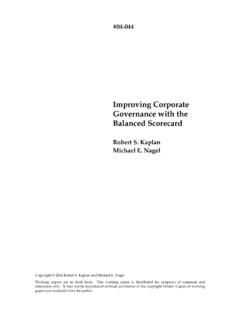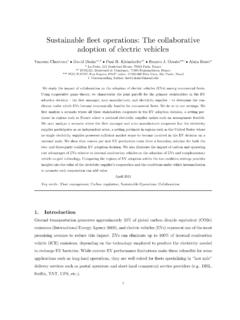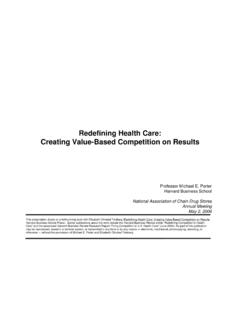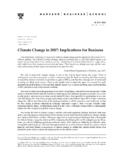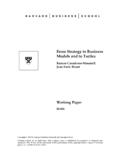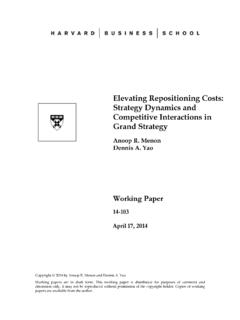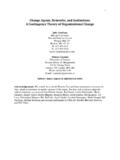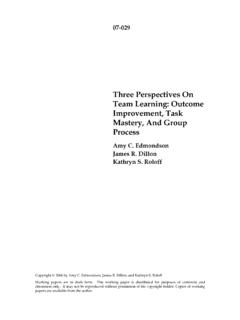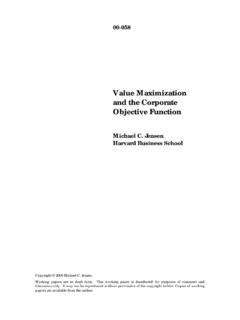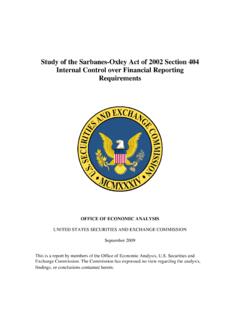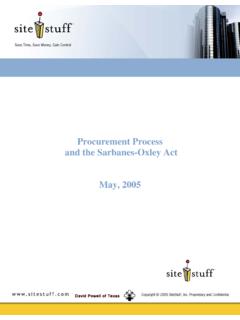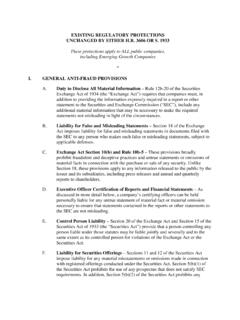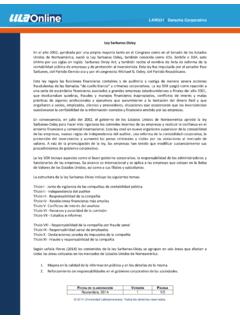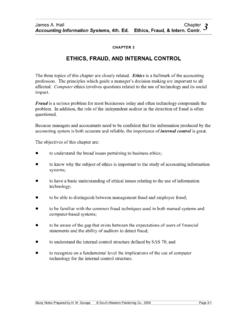Transcription of The Structure of Board Committees - Harvard Business School
1 The Structure of Board Committees Kevin D. Chen Andy Wu Working Paper 17-032 Working Paper 17-032 Copyright 2016 by Kevin D. Chen and Andy Wu Working papers are in draft form. This working paper is distributed for purposes of comment and discussion only. It may not be reproduced without permission of the copyright holder. Copies of working papers are available from the author. The Structure of Board Committees Kevin D. Chen University of Pennsylvania Andy Wu Harvard Business School 1 The Structure of Board Committees Kevin D. Chen Department of Economics University of Pennsylvania Andy Wu Strategy Unit, Harvard Business School Harvard University September 2016 Abstract. We document and analyze Board committee structures utilizing a novel dataset containing full Board committee membership for over 6,000 firms.
2 Board Committees provide benefits (specialization, efficiency, and accountability benefits) and costs (information segregation). Consistent with these benefits and costs, we find that committee activity increases with firm size, the proportion of outside directors, Board tenure and size, and public information available to outside directors. Moreover, boards allocate directors in ways to alleviate information segregation through multi-committee directors. Specifically, multi-committee directors tend to serve on related Committees and be outside directors with more expertise and experience. Also, busy directors are less likely to serve on multiple Committees , possibly to avoid being overloaded. JEL Classification: G3, M4 Keywords: corporate governance, Board of directors, Board Committees , specialization, accountability, information segregation, multi-committee directors 2 1.
3 Introduction Despite the central role of boards in in corporate governance,1 there is relatively little understanding of the internal organization of boards, specifically the Structure of Board Committees . Such Committees are important because, as Kesner (1988) and Klein (1998) suggest, committee meetings, and not the Board meetings, are where most Board activity actually takes place. Adams et al. (2015) find that 52% of Board activity in S&P 1500 firms takes place at the committee level after the implementation of Sarbanes- oxley . Specific tasks that take place within Board Committees include both monitoring tasks (such as auditing and management compensation) and advising tasks (for example, Morgan Stanley has a technology committee that advises the Board and management team on Big Data tools and systems that control stock trading).
4 2 Understanding how Board Committees are structured, therefore, allows us to gain deeper insights into the role of boards and their optimal design. We propose a framework of benefits and costs of Committees that boards balance when implementing committee structures. Board Committees provide three benefits. First, Committees through the process of decentralization can allow for knowledge specialization (De Kluyver, 2009), which benefits firms because the monitoring and advising tasks of boards are complex and require firm-specific knowledge (Kim et al., 2014). Second, specialization through Committees can allow for a more efficient task allocation to directors, leading to task-division efficiency. Third, Committees can increase the accountability of the Board to the firm by reducing individual free-riding and enabling outside directors to perform their monitoring duties more effectively through greater separation from management.
5 Despite these benefits, there is also a cost associated with Board Committees : Board Committees can lead to information segregation for the directors not on a specific committee (Reeb and Upadhyay, 2010). In light of these tradeoffs, we then explore the concept of multi-committee directors (MCDs), directors who sit on 2 or more Committees on the same Board , and we propose that boards can moderate committee benefits and costs through the MCDs. We test these mechanisms by confirming hypothesized relationships between committee activity and observed firm characteristics; specifically, we document whether firms with greater potential benefits (costs) from Committees have more (less) committee We utilize a novel dataset from Equilar to examine the nature of committee Structure and the allocation of directors across Committees .
6 The dataset contains complete committee membership information, including the membership of non-required Committees , for directors from firms listed on the 1 Recent work has documented general characteristics of boards, such as Board size, busyness, and outside vs. inside directors. See Linck et al., 2008; Boone et al., 2007; Fich and Shivdasani, 2006; Coles et al., 2008; Armstrong et al., 2014. 2 Morgan Stanley Board Pushes Emerging Area of Tech Governance by Kim Nash, 2015. 3 We use two difference measures of committee activity: the number of Committees and the total number of committee meetings. 3 Russell 3000 from 2001 to 2013. Full committee data has not been widely available (Jiraporn et al., 2009; Adams et al., 2010), especially with coverage of both required Committees (audit, compensation, and nominating/corporate governance) and non-required Committees ( , finance, technology, and strategy).
7 Using this comprehensive panel dataset of over 6,000 unique firms, we first document the Structure of Board Committees . Our descriptive analysis reveals that: (1) the use of certain commonly mentioned non-required Committees including finance, technology, strategy, ethics, and diversity is relatively rare; (2) the number of Board Committees has been fairly stable over time; (3) the majority of directors sit on multiple Committees . Our regression analysis provides support for the theorized benefits (knowledge specialization, task-division efficiency, and accountability) and the cost (information segregation). Consistent with the view that Committees enable knowledge specialization, we find that committee activity increases with firm size and the proportion of outside directors; larger firms and firms with more independent boards have higher benefits from specialization, because larger firms face more complex issues than smaller firms (Linck et al.)
8 , 2008; Lehn et al., 2008), and outside directors face higher costs to accumulate knowledge about the firm (Kim et al., 2014).4 Next, consistent with the view that Committees provide task-division efficiency and accountability benefits, we find that Board size and boards where the CEO is also the chairman (CEO Duality) are positively associated with committee Large boards incur higher costs during communication and coordination as well as higher costs from the free-riding problem (Reeb and Upadhyay, 2010), and boards where the CEO is also the chairman may have greater agency problems (Brickley et al., 1997). Furthermore, we find that the proposed benefits (knowledge specialization, task-division efficiency, and accountability) may heterogeneously affect the value of different types of Committees in a specific examination of the executive and finance Committees , the two most common non-required Committees .
9 On the other hand, consistent with the view that Committees can have information-segregation costs, we find that committee activity is lower when Board tenure is shorter or when less public information is available to outside directors. Outside directors with shorter tenure have less firm-specific knowledge (Kim et al., 2014), resulting in greater information asymmetry between management and outside directors and greater information-segregation costs from using Committees . Outside directors can likely overcome information segregation if there is more public information available. 4 Firm size is likely exogenous to the number of Committees , but the proportion of outside directors may be endogenous as boards with more Committees may look for more outside directors.
10 We address this potential reverse causality issue in Section through an exogenous shock to the number of Committees to assess the extent with which boards add directors in order to staff Committees . 5 We address possible endogeneity between Board size and the number of Committees using the exogenous shock as well. 4 Boards can moderate these committee benefits and costs through the use of multi-committee directors (MCDs), directors who sit on 2 or more Committees on the same Board . MCDs can reduce information-segregation costs of Committees when allocated properly: we find that Committees related to each other, such as the audit and loan committee, are more likely to have overlaps by MCDs. Furthermore, directors with expertise and experience as proxied by their financial expertise and tenure are more likely to be assigned to multiple Committees .
